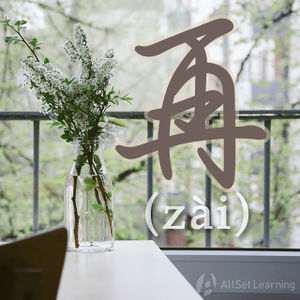Difference between revisions of "Sequencing with "xian" and "zai""
| Line 1: | Line 1: | ||
{{Grammar Box}} | {{Grammar Box}} | ||
| − | + | The word [[再|再 (xài)]] actually has a lot of uses, beyond just [[Again in the future with "zai"|"again."]] "先..., 再..." (xiān..., xài...) is a pattern used for sequencing events, much like "First..., then..." in English. | |
| − | + | == General Usage of 先……再…… == | |
| + | |||
| + | In the pattern below, 再 has a meaning of "then" or "and then." | ||
| + | |||
| + | === Structure === | ||
<div class="jiegou"> | <div class="jiegou"> | ||
| − | 先 + Event 1 + 再 + Event 2 | + | 先 + [Event 1] + 再 + [Event 2] |
</div> | </div> | ||
| − | == Examples == | + | === Examples === |
<div class="liju"> | <div class="liju"> | ||
| Line 21: | Line 25: | ||
</div> | </div> | ||
| − | == | + | == Using 再说 == |
| − | + | ||
| − | + | You may have learned that [["In addition" with "zaishuo"|"再说" can mean "in addition."]] Well, this usage of 再 is a more literal combination of 再 + 说, fitting into the 先……再…… pattern. | |
| + | |||
| + | So in this usage, 再说 doesn't really mean "in addition." Rather, it most literally means "and then we'll talk." In other words, "let's just do this now," and then after we see the result, we can talk some more about next steps. There's kind of a "let's see how this goes first" feeling to the expression. | ||
| + | |||
| + | === Structure === | ||
| + | |||
| + | Note that in the pattern below, the sentence normally ends with 再说. | ||
| + | |||
| + | <div class="jiegou"> | ||
| + | |||
| + | 先 + [Event 1] + 再说 | ||
| + | |||
| + | </div> | ||
| + | |||
| + | === Examples === | ||
| + | |||
| + | <div class="liju"> | ||
| + | |||
| + | * <em>先</em> 吃饭 <em>再说</em> 。 | ||
| + | * <em>先</em> 做 完 这个 <em>再说</em> 。 | ||
| + | * <em>我</em> 先 上 个 厕所 <em>再说</em> 。 | ||
| + | * 我们 <em>先</em> 休息 一下 <em>再说</em> 。 | ||
| + | * 你们 <em>先</em> 讨论 一下 <em>再说</em> 。 | ||
| + | |||
| + | </div> | ||
== Sources and further reading == | == Sources and further reading == | ||
Revision as of 03:01, 7 January 2013
-
Level
-
Similar to
-
Used for
-
Keywords
The word 再 (xài) actually has a lot of uses, beyond just "again." "先..., 再..." (xiān..., xài...) is a pattern used for sequencing events, much like "First..., then..." in English.
Contents
General Usage of 先……再……
In the pattern below, 再 has a meaning of "then" or "and then."
Structure
先 + [Event 1] + 再 + [Event 2]
Examples
- 我 会 先 洗 手,再 吃 晚饭。
- 她 要 先 吃 早饭,再 去 学校。
- 他 的 朋友 都 先 看 电影,再 去 酒吧。
Using 再说
You may have learned that "再说" can mean "in addition." Well, this usage of 再 is a more literal combination of 再 + 说, fitting into the 先……再…… pattern.
So in this usage, 再说 doesn't really mean "in addition." Rather, it most literally means "and then we'll talk." In other words, "let's just do this now," and then after we see the result, we can talk some more about next steps. There's kind of a "let's see how this goes first" feeling to the expression.
Structure
Note that in the pattern below, the sentence normally ends with 再说.
先 + [Event 1] + 再说
Examples
- 先 吃饭 再说 。
- 先 做 完 这个 再说 。
- 我 先 上 个 厕所 再说 。
- 我们 先 休息 一下 再说 。
- 你们 先 讨论 一下 再说 。
Sources and further reading
Books
- Integrated Chinese: Level 1, Part 1 (3rd ed) (pp. 258-9) →buy
- Integrated Chinese: Level 2, Part 2 (pp. 19-20) →buy



